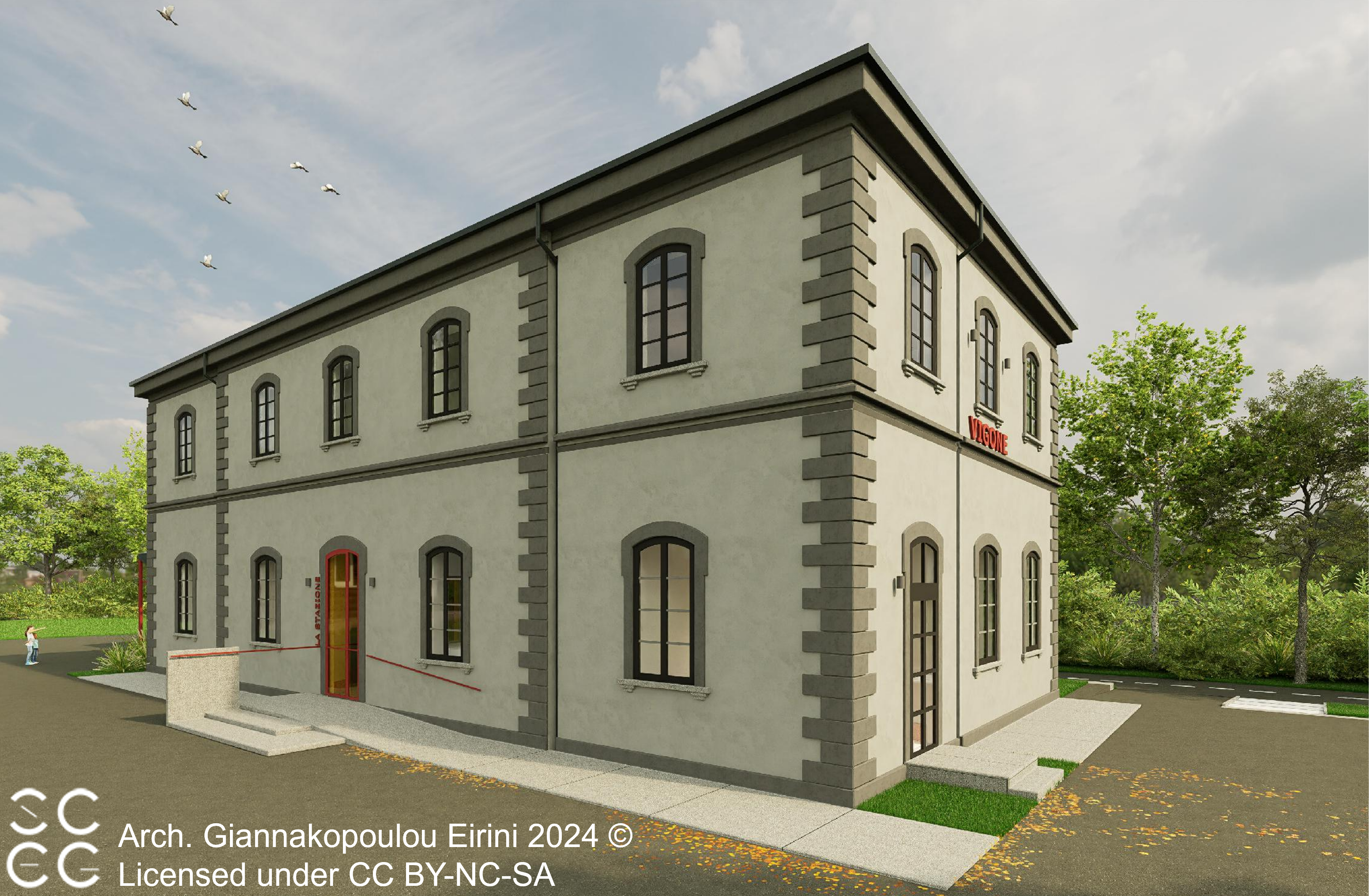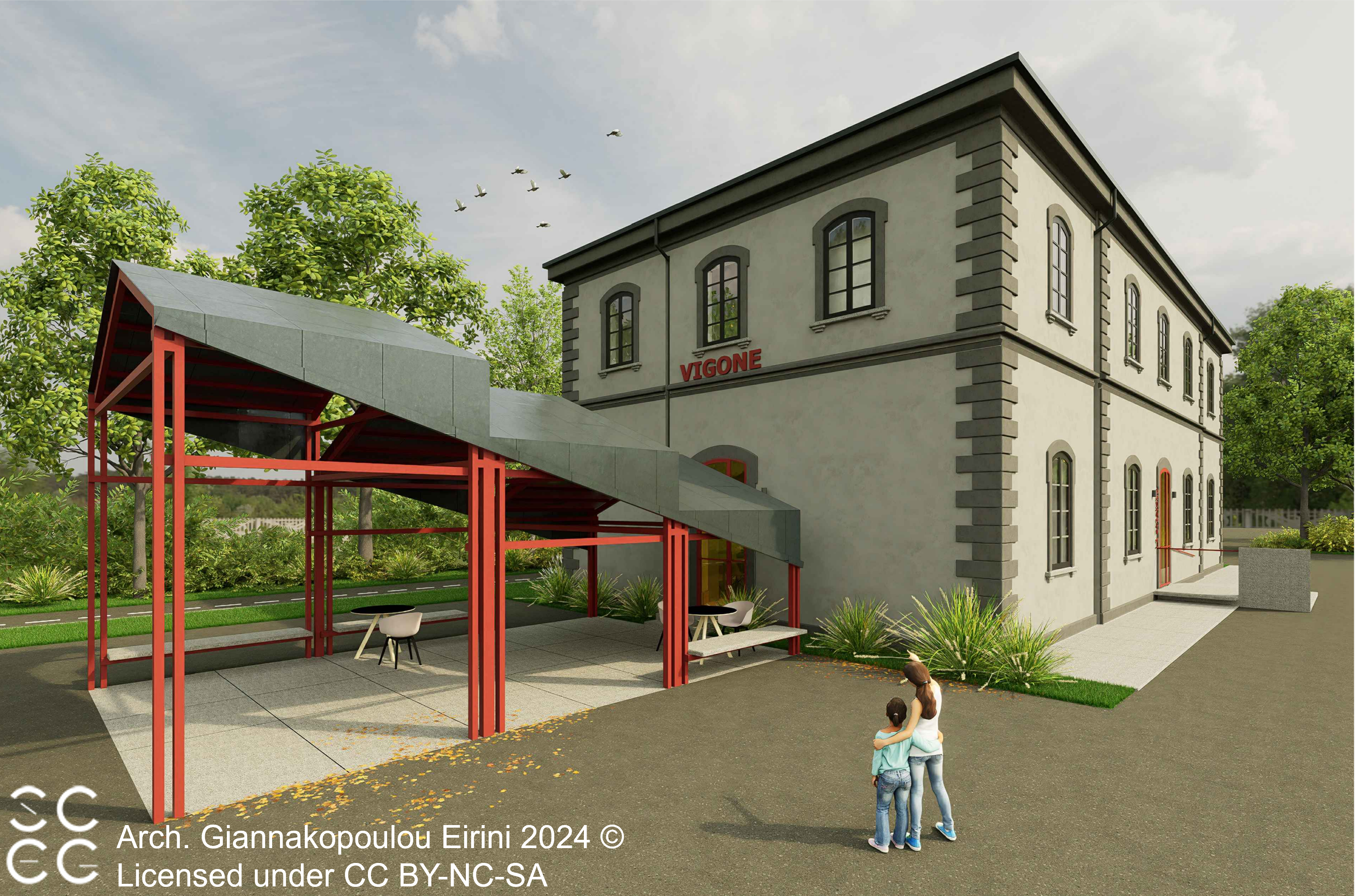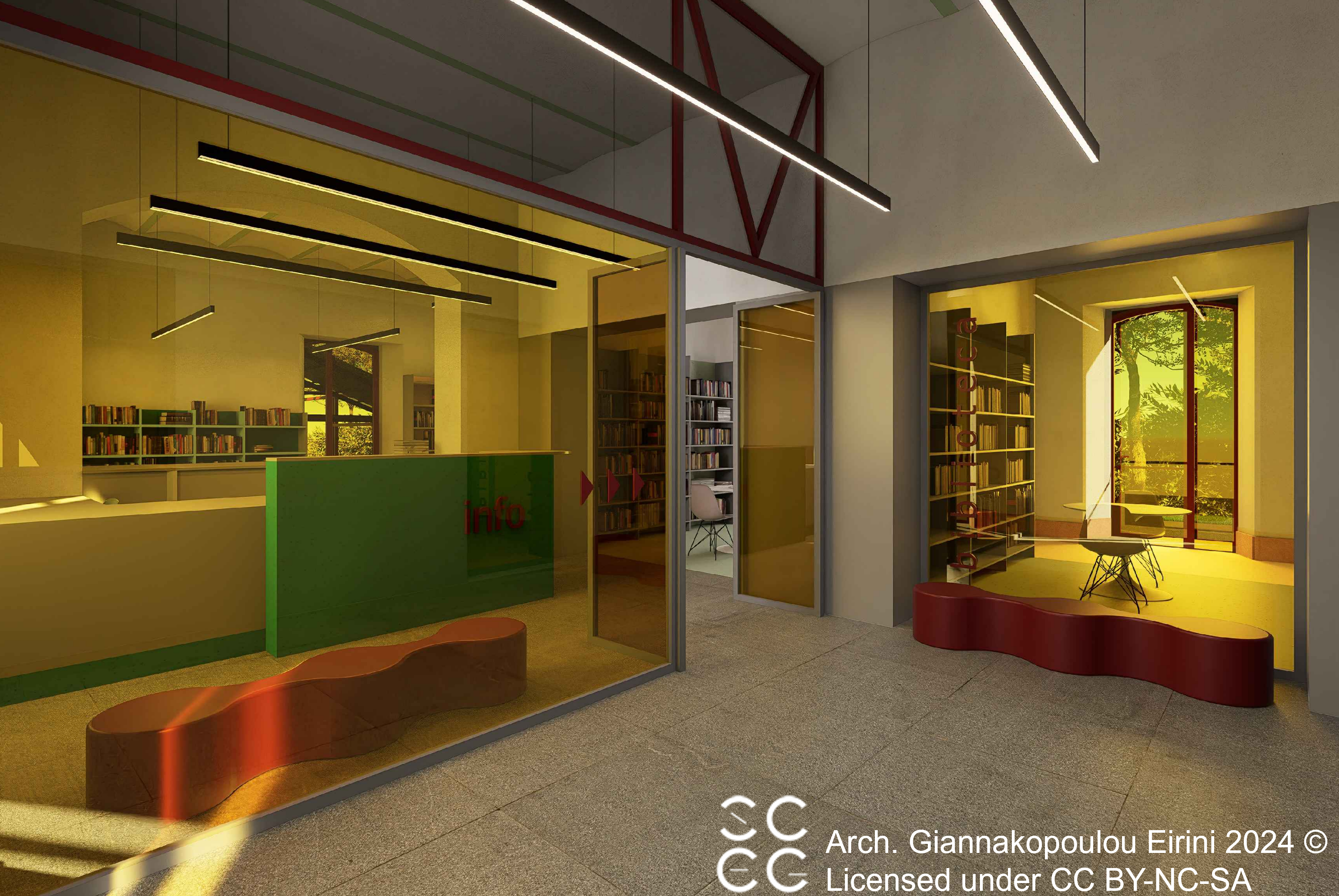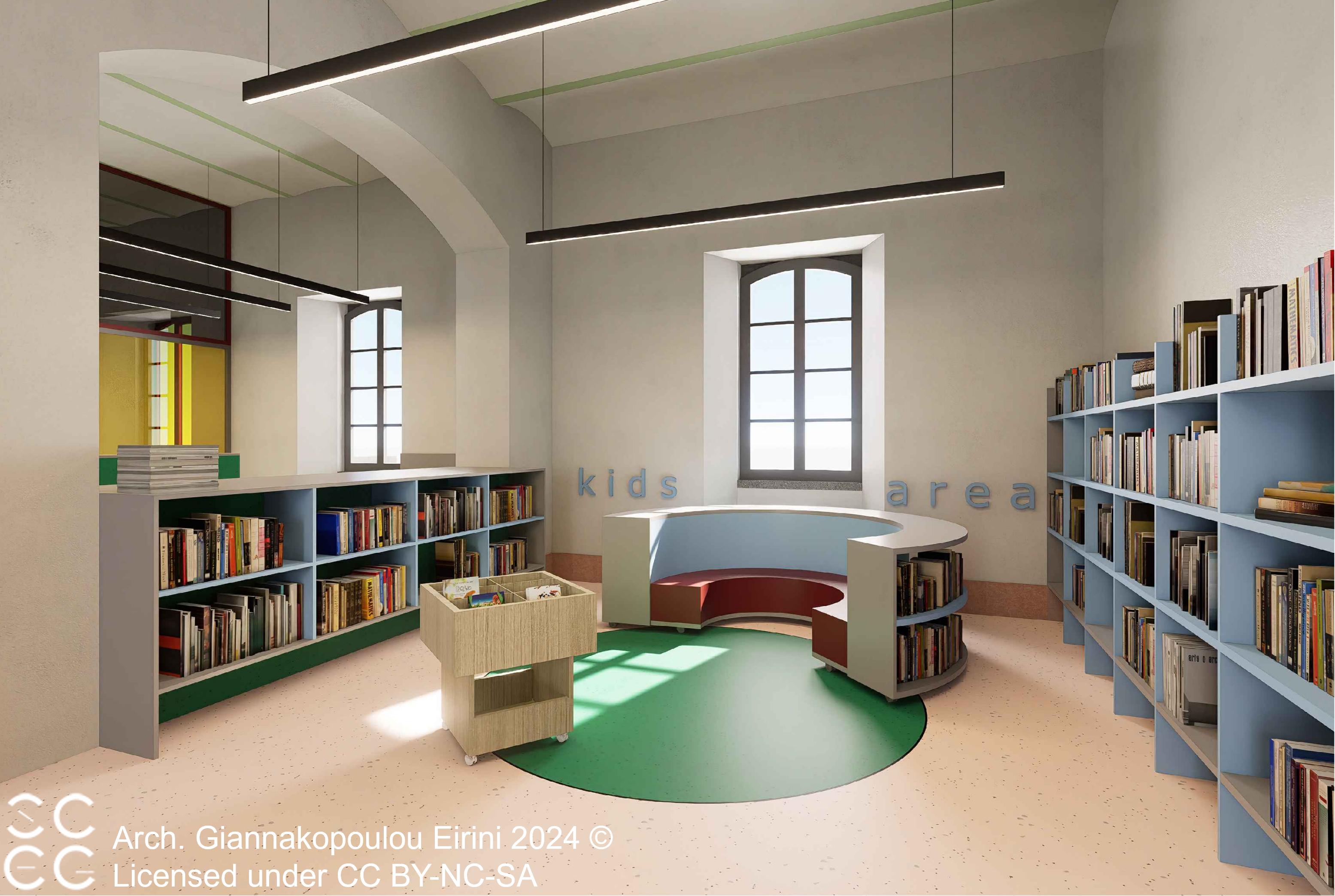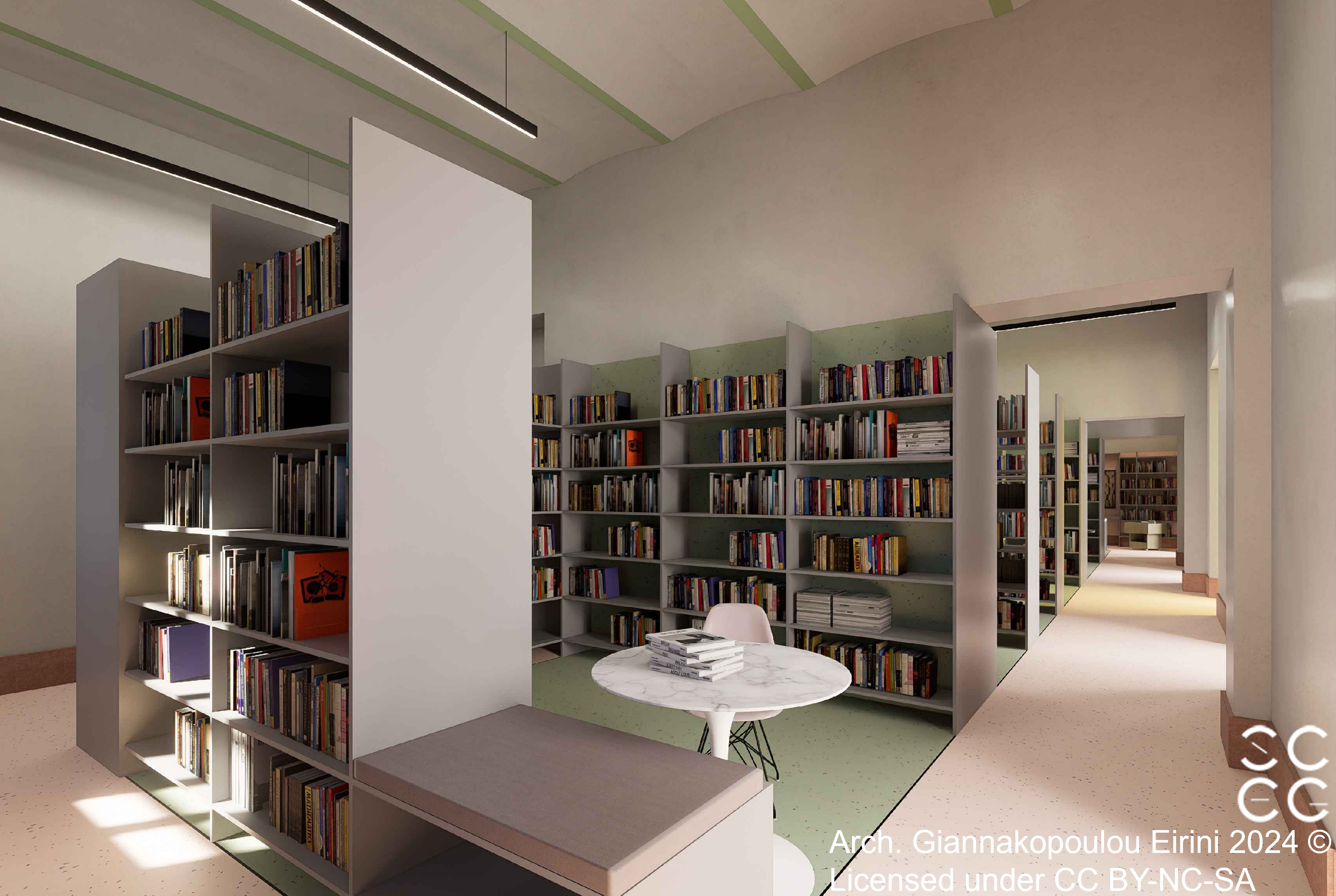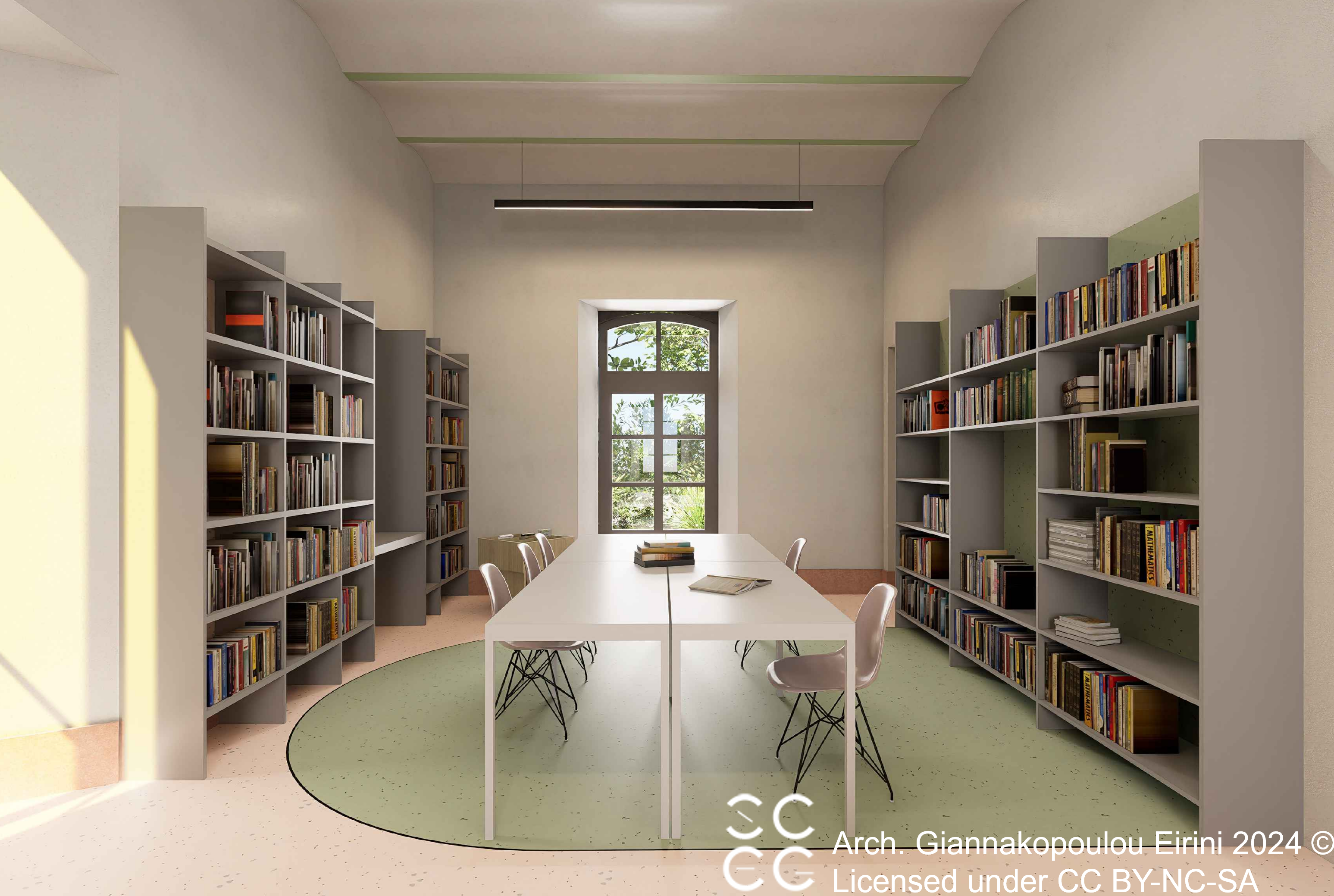Vigone towards the Future!
From Abandoned Railway Station to a Zero-Emission Library, Student Center, and Co-Working Hub
Rural villages can overcome future challenges of depopulation and aging through education, digitalization, and sustainability. In the past Vigone railway station bridged the village to the city of Turin, enabling young citizens to attend the university and commute. The renovated station will become a sustainability hub containing Library, Student Center, and Co-working spaces, securing a shelter for young citizens and digital nomads, immersed within Art, bike paths, and Natural Springs.
Italy
Piazza Clemente Corte 16, Vigone, 10067, Italy.
Link google maps: https://maps.app.goo.gl/GkyCR9wUzWBrGTpw5
Link google maps: https://maps.app.goo.gl/GkyCR9wUzWBrGTpw5
Prototype level
Yes
Yes
Yes
Yes
ERDF : European Regional Development Fund
EU-based Development and Cohesion fund mediated by the Italian government and the regional Piedmontese government (https://www.regione.piemonte.it/web/temi/fondi-progetti-europei/fondo-sviluppo-coesione-fsc)
No
001299: Vigone (IT)
The project aims to renovate the city's railway station, currently in a state of decay and abandonment, returning it to the citizenship, especially the young citizens. The station is located along the 14 km cycle path that connects the neighboring small municipalities to the Airasca railway station (still working), within the city park enriched by artistic works, the famous "Artist’s Benches", the gatehouse decorated by the Uruguayan artist Coco Cano, and at short distance from several springs in the Vigone countryside. Preserving the cultural heritage of the structure, the interior spaces will be renovated so as to create: (i) a new headquarters for the City Library, with large and bright spaces for children and adolescents on the ground floor; (ii) a large conference/meeting room on the first floor for city associations, study rooms and co-working spaces for young citizens and digital nomads with independent access. The intervention will be carried out in full climate neutrality. To preserve the surrounding artistic context, the building will feature a work by the Turin artist Hilario Isola.
The project targets four main target groups to address the ongoing ageing and depopulation: (i) families with children; (ii) young students (about 800 up to 29 years of age in Vigone); (iii) citizen associations; (iv) digital nomads. The target group is not limited to citizens of Vigone, but, thanks to the cycle path, the intervention will involve five other medium-small municipalities in the area in a sustainable way. The specific objectives are: (i) to educate young people from Vigone about beauty and sustainability; (ii) attracting young people from other cities; (iii) to establish new social spaces for associations; (iv) enable inclusive and free education. Among the expected changes we list: (i) a greater sense of community thanks to new spaces; (ii) attraction and retention of young people in the area; (iii) positive effects on the birth rate.
The project targets four main target groups to address the ongoing ageing and depopulation: (i) families with children; (ii) young students (about 800 up to 29 years of age in Vigone); (iii) citizen associations; (iv) digital nomads. The target group is not limited to citizens of Vigone, but, thanks to the cycle path, the intervention will involve five other medium-small municipalities in the area in a sustainable way. The specific objectives are: (i) to educate young people from Vigone about beauty and sustainability; (ii) attracting young people from other cities; (iii) to establish new social spaces for associations; (iv) enable inclusive and free education. Among the expected changes we list: (i) a greater sense of community thanks to new spaces; (ii) attraction and retention of young people in the area; (iii) positive effects on the birth rate.
Education
Inclusion
Art
Sustainability
Community
The renovation of the building of the former Vigone station towards a structure with almost zero emissions is the culmination of a two-year period of energy efficiency interventions on municipal buildings. In the past, through EU and national funds and thanks to the support of the municipal Energy Manager, the Municipality of Vigone has invested over 2 million euros for renovation. The municipal administration is now putting into practice the experience gained towards this ambitious project: the transformation of a ruin into a sustainability hub. Insulation of perimeter walls and roofs will be improved. The air conditioning will be entirely taken care of by heat pumps with electricity consumption, so as to maximize the use of renewable energy, produced by photovoltaic systems installed at the west/east (80 m2 each) and south (30 m2) slopes. The structural interventions will be limited to making the building (i) safe, (ii) more energy efficient, more functional, avoiding unnecessary waste of energy and materials during renovation. Thanks to the crossroads position of the former station along the "Via delle Risorgive" cycle path, respectively 7 km from the nearby Airasca railway station and 7 km from the opposite pole Moretta, access to the structure will be maximized through soft mobility (bicycle, on foot) also from other municipalities. Finally, given the proximity to the nature reserves of the Vigonese resurgences, accessible on foot or by bicycle from the station, a broad knowledge of nature will be promoted to users and a better integration within a rural and non-urbanized world. In Italy alone, there are about 1,500 km of disused railway lines, many of which are being converted to cycle-pedestrian paths. The renovation of the Vigone station can be a useful example to guide the conversion of many other disused stations into zero-emission buildings with a social purpose.
The project does not only aspire to functionality, but to make the cultural center the culmination of the neighboring art park. In fact, the former avenues of the station are already embellished with 14 artists’ benches owned by the municipality, created by famous international artists during the annual exhibition "Artist's Benches". On the avenue leading to the station there is the former railway gatehouse, whose external walls are decorated with a work by the Uruguayan artist Coco Cano. While preserving the nineteenth-century stylistic beauty of the historic building of the former station, the interior spaces will maximize the cultural experience of users. Families and adults entering the building will find an immense window with a perspective on the entire first floor. The children's area on the left will include carpets, a small amphitheater, and shelves directly accessible by young users. The additional rooms will have modern book shelving. The choice of chairs and tables will be preparatory to making the spaces functional and modern, allowing an evolution from the historicity of the external walls (the past) to the interior (the future). The second floor will be affected on the left by a conference/meeting room enriched with modern shelving, comfortable chairs, computers and projector. The space on the right will instead be dedicated to education and digitization, with the creation of co-working and study rooms. To facilitate a happy and pleasant education, a games room will be set up with billiards and other board games, so as to also encourage the sociality of users. The experience will be enriched by a modern canopy outside, with direct access from the children's area. The ambition and exemplary nature of the project lie in its being unique for a small community. Besides, our small rural town, culminating in its evolution, is enriched with a cultural and beautiful space, demonstrating that this opportunity is not limited only to larger cities.
Our project is unique because in the context of depopulation, aging, and economic difficulties, rather than entrusting a public asset to private use we return it to the community, favoring families, associations, and the adolescent segment of the Vigone population, minority groups of the city community. While access to the present Municipal Library is held back by the narrow internal spaces, the presence of architectural barriers that are difficult to overcome, and the secluded position with respect to the city center, the new structure will be located on the first ground floor and the outdoor spaces will be sized to allow easy access. The new cultural hub is located along the "Via delle Risorgive" cycle path, thus facilitating its reach also thanks to soft mobility for families and adolescents from other municipalities. Its location in the center of the city park, which already houses a children's playground, a kiosk-bar areas for practicing various sports and a fitness trail, will make it even more attractive. The spaces on the first floor, on the other hand, allow the inclusion of social groups that are currently penalized for the lack of opportunities to meet within our community. The conference / meeting room will be a neutral space offered to associations or ordinary citizens for initiatives of discussion and exchange. The coworking, study and game rooms will allow young Vigonese teenagers to be able to work and study in their country, without the need to go to the facilities of the larger cities. Free internet access will be provided and the possibility of offering computers will be evaluated to break down any educational barrier for less affluent students. Access to the first floor will be mediated through the use of badges, so that students can have a haven for leisure and study whenever necessary. If successful, this initiative will finally allow a return from the big cities to the small villages, limiting the terrible effects of crazy urbanization.
The ambitious idea of the cultural hub, given its economic scope and impact on the territory, is certainly not pushed only by the Municipal Administration, but is rather a result of city and territorial synergies. Since the late 80s, the building of the former station has been abandoned and the city has had decades to wonder about its future. Once the property was acquired during the previous mandate, the current Administration has implemented a long discussion with citizens, municipalities in the area, experts, and associations to identify the best use. The Municipality has involved local associations in the project "REGION 4.7: Territories for Global Citizenship Education". Through interviews with Vigonese testimonials developed by experts from the Department of Psychology of the University of Turin and two face-to-face meetings (08/11/23 and 25/10/24), ideas on how to improve the associative fabric were collected. From here, the desire to return the former station to the community initially emerged. At this point, an interlocution was started with the archivist of the Municipality, the councilor with delegation to the Library and the Librarian, to the feasibility of transferring the old Library to the new one. Once a technical confirmation was obtained, it was therefore decided to organize an open assembly with the citizens on May 28, 2024, in which the intention to use the former station as a cultural hub was presented. The meeting was very well attended, especially among the younger citizens, and a mechanism for the active involvement of the community in the implementation phase of the project was agreed. Thanks to the involvement of associations, Vigonese teenagers, families and professionals, we will be able to build spaces suitable for the needs of users. In addition, citizens will thus feel the former station as their project, ensuring its sustainability over time even after the end of the current legislature.
Citizen associations and citizens were involved in the conception of the initiative through several open meetings, including the two cycles within the regional call and the open assembly with citizens. In addition, the initiative was widely communicated through the publication of the monthly city review VIGO-NEws, the internet and social channels of the municipality, and articles in the local newspaper L'eco del Chisone. Once the executive design has been completed, for which a group of nationally renowned Turin architects has been chosen, a working table will be set up with associations and young people, so as to set up the spaces on the first floor according to their needs. To have the broadest possible view of future users, researchers from the Department of Psychology of the University of Turin were involved. In addition, the local perspective was enriched thanks to a doctoral thesis from the Polytechnic University of Turin on the transition of the former station into a functional hub for associations.
Given that a project of such ambition cannot only have a local scope, it was proposed as a common thread for the use of almost 4 million euros of regional, national and community funds on the territory of 19 municipalities in the Turin area within a meeting between mayors held in Vigone on 7 November 2024 with the presence of the Regional Councilor Gian Luca Vignale. The project was embraced by some municipalities of the partnership interested in disused stations and well evaluated by the regional body disbursing the funds.
A European vision is inherent in the project, as the design was carried out by the Greek architect Eirini Giannakopoulou with ideas from Councillor Dattila, deputy for public works, innovation, digitalisation and energy transition and researcher at the Polytechnic University of Turin with 6 years of experience abroad (Sweden, Spain, the Netherlands, Switzerland), beneficiary of several European grants, including a Marie Skłodowska-Curie.
Given that a project of such ambition cannot only have a local scope, it was proposed as a common thread for the use of almost 4 million euros of regional, national and community funds on the territory of 19 municipalities in the Turin area within a meeting between mayors held in Vigone on 7 November 2024 with the presence of the Regional Councilor Gian Luca Vignale. The project was embraced by some municipalities of the partnership interested in disused stations and well evaluated by the regional body disbursing the funds.
A European vision is inherent in the project, as the design was carried out by the Greek architect Eirini Giannakopoulou with ideas from Councillor Dattila, deputy for public works, innovation, digitalisation and energy transition and researcher at the Polytechnic University of Turin with 6 years of experience abroad (Sweden, Spain, the Netherlands, Switzerland), beneficiary of several European grants, including a Marie Skłodowska-Curie.
The project blends (i) the ten-year artistic vision of the Mayor of the Municipality of Vigone Fabio Cerato and the "Panchine d'Artista" Association, active in the area for over a decade on the theme of contemporary art, (ii) the experience of the architect Eirini Giannakopoulou, professor at the Institute of Applied Art and Design in marrying functionality with beauty, (iii) the training skills of the librarian Francesca Leoni, with a master's degree in History, Theories and Techniques of Children's Literature, (iv) the sociological knowledge by the researchers of the Department of Psychology of the University of Turin, (v) structural sustainability by the PhD students of the Department of Architecture and Design of the Polytechnic of Turin, (vi) the focus on energy efficiency, by the Energy Manager Engineer Stefano Perassi, (vii) the innovative and digital vision of Councillor Federico Dattila.
Although the sustainable and inclusive concept was already embedded in the theses of the researchers of the university and the Polytechnic, it is only thanks to the vision of the municipal energy manager that we move towards a zero-emission building. Once the idea was defined, the librarian's training experience allowed further ideas for improvement, such as the outdoor canopy. The educational and digital aspect of the first floor was included thanks to the European vision of Councillor Federico Dattila, mindful of his years as a student in modern Swedish bookstores and study rooms. Finally, the artistic horizon of the Mayor of the Municipality of Vigone Fabio Cerato and the "Panchine d'Artista" Association has allowed the involvement of the architect Giannakopoulou, so as to evolve from a simple functional hub to a jewel for the community. In particular, the mayor's entrepreneurial spirit has allowed that in a few years, a dream in the drawer has become a next reality.
Although the sustainable and inclusive concept was already embedded in the theses of the researchers of the university and the Polytechnic, it is only thanks to the vision of the municipal energy manager that we move towards a zero-emission building. Once the idea was defined, the librarian's training experience allowed further ideas for improvement, such as the outdoor canopy. The educational and digital aspect of the first floor was included thanks to the European vision of Councillor Federico Dattila, mindful of his years as a student in modern Swedish bookstores and study rooms. Finally, the artistic horizon of the Mayor of the Municipality of Vigone Fabio Cerato and the "Panchine d'Artista" Association has allowed the involvement of the architect Giannakopoulou, so as to evolve from a simple functional hub to a jewel for the community. In particular, the mayor's entrepreneurial spirit has allowed that in a few years, a dream in the drawer has become a next reality.
The definition of community study and social space is a characteristic of large cities, with considerable economic resources and strong demand from the younger sections of the population. Although they maintain an innovative appearance, these structures are guilty of the excessive urbanization of the concentric, so that the functional aspect is often not combined with an artistic and sustainable side. Conversely, social spaces in small municipalities are often relegated to old abandoned structures, with a high energy impact, and in unfavorable positions. In rural villages, people boast of their practicality and decide to leave the "beauty" to the metropolises, without realizing that, in doing so, they end up debasing their territory and encouraging the emigration of their young people to cities with more services.
Our administration, on the other hand, believes that a training education, in addition to being free to access, must be included in art and greenery, so as to train the new generations to respect the surrounding environment and the pre-existing cultural heritage. In a historical moment of transition from public to private, our project wants to reaffirm the role of the public in the creation of community spaces, to be allocated to their associations and young people. By moving our library from a historic building to the central building of the former station, our approach restores the centrality of education and culture even for small towns, emphasizing the need to start from these foundations to encourage a better future.
Perhaps the aspect that makes this project particular and unique is represented by the fact that, while involving many stakeholders, it was decided to start from the community and therefore to choose a use of the asset of clear interest for the citizenry. The project, son of the community, grows with it and reflects its needs, without an intellectualistic vision being imposed from above.
Our administration, on the other hand, believes that a training education, in addition to being free to access, must be included in art and greenery, so as to train the new generations to respect the surrounding environment and the pre-existing cultural heritage. In a historical moment of transition from public to private, our project wants to reaffirm the role of the public in the creation of community spaces, to be allocated to their associations and young people. By moving our library from a historic building to the central building of the former station, our approach restores the centrality of education and culture even for small towns, emphasizing the need to start from these foundations to encourage a better future.
Perhaps the aspect that makes this project particular and unique is represented by the fact that, while involving many stakeholders, it was decided to start from the community and therefore to choose a use of the asset of clear interest for the citizenry. The project, son of the community, grows with it and reflects its needs, without an intellectualistic vision being imposed from above.
For the development of the initiative, it was decided to start from the origins. The presence of university researchers within the project team has allowed the inclusion of tools for active participation such as working tables, brain storming moments, interviews with stakeholders. However, while using these approaches, the practical methodology of the small rural centre was chosen. Just as a strong democracy feeds on requests and direct confrontation with citizens, so, given the limited size of the interest groups (a dozen associations, a hundred active adolescents), it was possible to dialogue directly with them.
Initially, members of the municipal administration visited similar centers in the area (although smaller and larger), so as to receive positive examples and also prospects for improvement. Once an initial proposal had been defined by the university partners, the architect, the municipal administration, and the library staff, it was decided to deepen the discussion through direct meetings with associations and interested citizens. To reach all stakeholders, a significant communication campaign was immediately launched through the press, social channels and the internet of the municipality, so as to reach the entire community. Once the idea had been validated at the city level, it was then decided to compare the project at the territorial and regional level, proposing itself as a common thread for the use of development and cohesion funds for the Turin plain. Having received positive feedback from the municipalities of the area, we were convinced of the goodness of the initiative. A direct confrontation was therefore started between the designer, library staff, associations and adolescents, so as to be able to create a functional environment that meets the needs of users.
Initially, members of the municipal administration visited similar centers in the area (although smaller and larger), so as to receive positive examples and also prospects for improvement. Once an initial proposal had been defined by the university partners, the architect, the municipal administration, and the library staff, it was decided to deepen the discussion through direct meetings with associations and interested citizens. To reach all stakeholders, a significant communication campaign was immediately launched through the press, social channels and the internet of the municipality, so as to reach the entire community. Once the idea had been validated at the city level, it was then decided to compare the project at the territorial and regional level, proposing itself as a common thread for the use of development and cohesion funds for the Turin plain. Having received positive feedback from the municipalities of the area, we were convinced of the goodness of the initiative. A direct confrontation was therefore started between the designer, library staff, associations and adolescents, so as to be able to create a functional environment that meets the needs of users.
At the Italian level, there are almost 8,000 municipalities, of which 70% have less than 5000 residents. Many of these are affected by disused railway lines, some of these have already been converted into cycle and pedestrian paths and with abandoned stations or toll booths. Due to depopulation, small rural towns have several unused buildings and the need to create new on-site services in the fields of education, work and digital. At the European level, it is reasonable to estimate that tens of thousands of small towns are in the same condition as our municipality
Our initiative can be easily transferred and replicated in each of these small towns, even with smaller sizes and therefore smaller funding needs. By enhancing abandoned buildings, in fact, it is thus possible to create small widespread centers of culture and education, curbing depopulation. The aspect of environmental sustainability can be directly re-proposed thanks to the huge communicator and national funds for the energy requalification of buildings. In particular, the creation of digital study rooms and co-working rooms is particularly sustainable, given the spread of internet connectivity networks (e.g. fiber) and the low cost of annual fees. The multi-disciplinary approach can be re-proposed by involving young citizens originally from small municipalities and moved to larger realities thanks to their families, and drawing useful ideas from them. Our experience teaches that there is a great willingness on the part of universities to accompany small municipalities free of charge towards their transition, and this approach can again be easily pursued by using young university student residents.
Given the simplicity of the discussion process, developed through continuous meetings and without particular need for space or technology, the participation of citizens requires only the commitment of local administrators and no economic resources.
Our initiative can be easily transferred and replicated in each of these small towns, even with smaller sizes and therefore smaller funding needs. By enhancing abandoned buildings, in fact, it is thus possible to create small widespread centers of culture and education, curbing depopulation. The aspect of environmental sustainability can be directly re-proposed thanks to the huge communicator and national funds for the energy requalification of buildings. In particular, the creation of digital study rooms and co-working rooms is particularly sustainable, given the spread of internet connectivity networks (e.g. fiber) and the low cost of annual fees. The multi-disciplinary approach can be re-proposed by involving young citizens originally from small municipalities and moved to larger realities thanks to their families, and drawing useful ideas from them. Our experience teaches that there is a great willingness on the part of universities to accompany small municipalities free of charge towards their transition, and this approach can again be easily pursued by using young university student residents.
Given the simplicity of the discussion process, developed through continuous meetings and without particular need for space or technology, the participation of citizens requires only the commitment of local administrators and no economic resources.
Our project aims to address several global challenges: (i) the depopulation of small rural towns; (ii) the subordination of art, culture and the environment to mere economic aspects; (iii) access to education and digitalisation for minority groups; (iv) the growing sense of loneliness of large sectors of the population.
By offering better training and local access to study rooms and coworking spaces, we aim to reverse the growing emigration of young Vigonese citizens to the large neighboring cities. By allowing the new generations to become attached to their cultural hub starting from childhood with the library and continuing with the study room on the first floor, we strengthen their bond with our territory, offering them opportunities for development on site.
By creating a space surrounded by greenery and art, in the heart of a cycle path, inserted in a network of environmental reserves with natural resurgences, we restore centrality to the public role as a promoter of culture, art and environmental protection. Using a structure with almost zero emissions, the new generations, as well as the associations present, will realize that the energy transition is compatible with development and growth and does not necessarily imply a reduction in services. By preserving the cultural heritage of the former station, but enriching it with modern interior spaces and a work by Hilario Isola, we increase the community's heritage.
By giving the possibility of independent access to the study room and internet connectivity, we break down educational barriers for adolescents in difficult contexts, allowing every young citizen to have a refuge that can be reached on foot or by bicycle.
By creating a special play space on the first floor and a meeting room for associations, we are giving back social spaces to our community, giving our citizens the opportunity to provide services and spaces for everyone.
By offering better training and local access to study rooms and coworking spaces, we aim to reverse the growing emigration of young Vigonese citizens to the large neighboring cities. By allowing the new generations to become attached to their cultural hub starting from childhood with the library and continuing with the study room on the first floor, we strengthen their bond with our territory, offering them opportunities for development on site.
By creating a space surrounded by greenery and art, in the heart of a cycle path, inserted in a network of environmental reserves with natural resurgences, we restore centrality to the public role as a promoter of culture, art and environmental protection. Using a structure with almost zero emissions, the new generations, as well as the associations present, will realize that the energy transition is compatible with development and growth and does not necessarily imply a reduction in services. By preserving the cultural heritage of the former station, but enriching it with modern interior spaces and a work by Hilario Isola, we increase the community's heritage.
By giving the possibility of independent access to the study room and internet connectivity, we break down educational barriers for adolescents in difficult contexts, allowing every young citizen to have a refuge that can be reached on foot or by bicycle.
By creating a special play space on the first floor and a meeting room for associations, we are giving back social spaces to our community, giving our citizens the opportunity to provide services and spaces for everyone.
The project has already passed the conception phase and the drafting of the executive project is now underway. In this first phase, the participation of the various sectors of citizenship was guaranteed through open working tables with the associations as part of the "Region 4.7" project, monthly discussions with the staff of the current library, receipt of feedback on various aspects from researchers from the University of Turin (social aspect) and the Polytechnic of Turin (sustainability aspect) and a first open assembly with citizens. Once the executive project is completed, a new phase of confrontation with the population will open, especially with the younger group. The executive project will be discussed with the population at the beginning of the summer and working tables will be organized with interested citizens to collect ideas on the preparation of the interior spaces, especially with respect to the study room, the co-working room and the meeting room. The project will also be carefully analyzed by the Energy Manager of the Municipality of Vigone, so as to verify the energy efficiency aspects.
Once this new phase of comparison is completed, it is expected to award the construction of the works by the end of November 2025. The works will continue for the entire year 2026. During these months, direct updates will be guaranteed to representatives at the working tables, associations, library staff and other interested citizens. During the works, as part of the 2026 "Artist's Benches" festival, the work of Hilario Isola will be created to accompany the structure. During 2026, a discussion will be started between the working tables, the municipal staff and the library to plan the management of the first floor. Younger citizens will be made responsible, so as to guarantee them a preponderant weight in the choices relating to their space. By summer 2027, the structure will be inaugurated and will finally become the heritage of the Vigonese community.
Once this new phase of comparison is completed, it is expected to award the construction of the works by the end of November 2025. The works will continue for the entire year 2026. During these months, direct updates will be guaranteed to representatives at the working tables, associations, library staff and other interested citizens. During the works, as part of the 2026 "Artist's Benches" festival, the work of Hilario Isola will be created to accompany the structure. During 2026, a discussion will be started between the working tables, the municipal staff and the library to plan the management of the first floor. Younger citizens will be made responsible, so as to guarantee them a preponderant weight in the choices relating to their space. By summer 2027, the structure will be inaugurated and will finally become the heritage of the Vigonese community.

